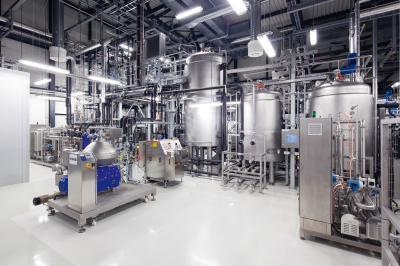Page added on March 26, 2014
There Will Be Oil! Unless It Gets Replaced By Sugar
Some people insist that Big Oil is in control of energy because so many products, from plastic to rubber, use it. It’s just the opposite, people came up with so many uses because it was there. To claim otherwise is like blaming toasters for the invention of electricity.
Peak Oil is now 20 years behind schedule but eventually doomsday prophets will be right. For that reason, researchers are investigating possibilities for using renewable raw materials to replace oil. One well-known example of this is biodiesel, which comes not from oil sources, but from fields of yellow-flowering rape. Isobutene, a basic chemical used in the chemical industry to produce fuels, solvents, elastomers or even anti-knock agents in fuel, could be produced from sugar.
Researchers at the Fraunhofer Center for Chemical-Biotechnological Processes CBP in Leuna are planning to set up a pilot plant.
Valuable product of “digestion”
The basis of this was provided by staff at the company Global Bioenergies: They introduced the unique metabolic conversion of sugar to isobutene into a microorganism: If sugar is added to this microorganism, it “digests” it – and out comes gaseous isobutene. To develop and construct this pilot plant, Global Energies will receive 5.7 million euros from the German Federal Ministry of Education and Research BMBF. The company got the CBP on board as a partner.
“We have the expertise for both the biotechnological and the chemical processes, and we meet all the requirements for successfully getting the project off the ground” said a very pleased Gerd Unkelbach, Director of CBP. “For example, we are able to handle isobutene: when mixed with air explosive mixtures are formed”.

In the pilot plant at the Fraunhofer Center for Chemical-Biotechnological Processes, researchers are producing oil substitutes from renewable raw materials. Credit: Gunter Binsack/Fraunhofer Center for Chemical-Biotechnological Processes
Construction of the 600 m2 pilot plant will start in the CBP technical center as of the fall of 2014 and it is planned that it will come into operation a year later. The large-scale processes will take place like in the laboratory: Sugar and the microorganism go into a fermenter which converts the sugar to gaseous isobutene. The isobutene is separated, purified, liquefied and filled into containers. Once the process has been transferred from the laboratory to the pilot scale, the plant will produce up to 100 tons of isobutene per year.
Sugar from wood
Sugar as a raw material has a big advantage over oil: It grows back. However, as a result of this, isobutene production is in competition with the food industry, as the sugar that ends up in the pilot plant is lost as a foodstuff. For this reason the researchers want to change tack in future, away from sugar from sugar beet to sugar from renewable raw materials that are not suitable as foods. Wood for example.
“The sugar we use is thus totally independent of food production” explained Unkelbach. The technological basis of this is already available at the CPB in the lignocellulose biorefinery. Here the researchers break wood down into its individual components: Cellulose, i.e. sugar, hemicelluloses and lignin.
11 Comments on "There Will Be Oil! Unless It Gets Replaced By Sugar"


Davy, Hermann, MO on Wed, 26th Mar 2014 1:48 am
Nothing more than a niche and will not scale. How many times have we discussed these bio fuel fantasies. Well like I say we need a buffet of plan B’s so this may work in a few locations. To scale it to a significant liquid fuel production source would leave us unable to grow enough food.
Makati1 on Wed, 26th Mar 2014 2:24 am
Dream on boys. Take your paychecks and dream of an impossible future until reality hits you smack in the face with that 2X4. Keep trolling for suckers to ‘invest’ in your dreams. You both will be disappointed in the long run.
Dave Thompson on Wed, 26th Mar 2014 3:41 am
“Peak Oil is now 20 years behind schedule but eventually doomsday prophets will be right”. This one sentence is all it takes for some.
rollin on Wed, 26th Mar 2014 3:48 am
The only practical solution is one that derives a liquid fuel from gaseous CO2 at relatively low temperature.
I would also like to know how they are converting cellulose to sugar. Cellulose is structurally different.
energyskeptic on Wed, 26th Mar 2014 3:56 am
Never has worked and never will work – if you look at a process from start to finish like systems analysts do, if even one step can’t be accomplished, the entire enterprise falls apart.
Peak Soil: Why Cellulosic and other Biofuels are Not Sustainable and a Threat to America’s National Security
http://energyskeptic.com/2014/peaksoil/
Arthur on Wed, 26th Mar 2014 5:06 am
http://en.wikipedia.org/wiki/Photosynthetic_efficiency
Sugar cane has the highest conversion efficiency of all crops: 7-8%
That comes close to solar panels: 10-15%
Brasil long ago has identified sugar as a means to keep the country automobilized.
Nevertheless, purely from an energy efficiency point of view, if you have a spare piece of ground you better install solar panels on it rather than have to harvest 25-30 times (life span solar panels) to achieve a lower energy harvest.
Biofuel has a place to utilise the leftovers of a crop raised for food purposes, not as a primary energy source.
Arthur on Wed, 26th Mar 2014 5:15 am
To elaborate on biofuel…
Here an example of an Austrian town named Guessing, that is 100% energy autark:
http://deepresource.wordpress.com/2013/10/16/gussing-austria-fossil-fuel-free/
This agrarian town heavily utilises biofuel from crop leftovers.
deedl on Wed, 26th Mar 2014 5:52 am
This is probably not a solution for large scale fuel production, but it can provide the feedstock for plastics needed in the medical sector or for other applications crucial to our well being.
DC on Wed, 26th Mar 2014 6:06 am
‘Science 2.0’ eh? More like Fantasy Island 2.0. Where in the article does it address the niggling problem that every feed stock they list are themselves, derived from(ineficent) FF powered processes? Last time I looked, sugar doesn’t reside in naturally occurring trillion barrel sized pools that we have to come along and shovel into a digester and presto! Energy crisis solved! Im pretty sure its grown in very energy intensive FF powered mega-scale industrial operations.
Still, this is a good example of ignoring the boundary issue. As long as pseudo-science websites like ‘Science’ 2.0 ignore where the sugar comes from and how much energy it takes to produce it, then ‘sugar’ does indeed look like a no brainer. I am pretty sure well see another equally glowing report from these guys on the cough ‘Hydrogen Economy’ and all its benefits too soon.
Makati1 on Wed, 26th Mar 2014 8:28 am
Arthur, those ‘left overs’ better go back into the ground if you don’t want to turn your soil into sand. How do you think soil is made if not from rotting debris from previous plants and the millions of microbes and other critters that live in a square meter of soil?
Newfie on Wed, 26th Mar 2014 10:03 am
Never ending growth is a fairy tale.